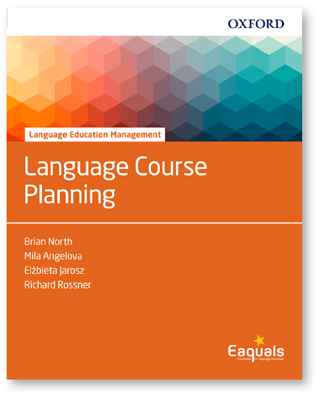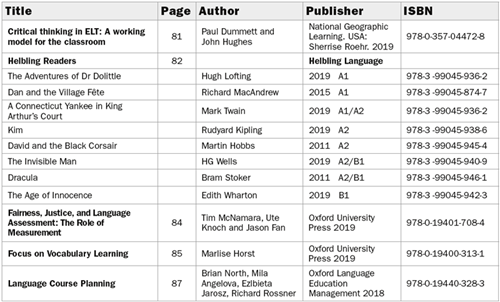Language Course Planning
Language Course Planning
Brian North, Mila Angelova, Ezlbieta Jarosz, Richard Rossner
Oxford Language Education Management 2018
See page 88 for details

Language Course Planning is a part of Oxford’s Language Education Management series. This series aims to provide an introduction to key quality assurance issues in language education. While the other two titles in the series focus on teaching competences and course management, this title delves into the planning element of course design. Specifically, it investigates the development of curriculum and syllabus and how language courses can be redesigned using the CEFR.
The stated purpose of this series is to present practical guidance for those who have responsibility for education management in the language teaching context. However, it will be of interest to prospective managers and those who carry out administrative/planning roles.
The book is broadly organised into four parts. The first presents some of the key considerations to take into account when planning a course or conducting needs analysis. The second part provides practical steps for managers to follow when revising curricula and syllabuses. The third part focuses on assessment (both for and of learning). The final part of the book provides some insight into the practical considerations of language course planning in a typical teaching context.
Language Course Planning is heavily influenced by the CEFR. As such, it is best positioned to meet the needs of those who work in contexts, or with materials, that are directly informed by the CEFR. That being said, the approaches taken in regard to syllabus and curriculum design are generalised enough that the book should be of benefit to most situations. In addition, the book’s emphasis on planning approaches that focus on learners and context make it relevant to most programmes.
One interesting feature of the book is the activities that are found throughout the chapters. These activities ask the reader to link the content to one’s own teaching context. As such, these activities could provide course managers/programme leaders with a ready bank of professional development tasks for staff.
Part one (Chapters 1–4) provides background and information which many experienced language teachers and course planners will be familiar with. Ideas such as can-do descriptors, curriculum types, needs analysis, and the importance of authentic content are covered. This makes for either an introduction to the concepts or an effective review for those wishing to refresh core principles.
In the second part of the book, the authors move into some of the specifics of course planning. For example, readers are taken through a step-by-step design process, and then classroom implementation of a syllabus is illustrated. Chapter 7 provides a strong introduction to the use of scenarios in course implementation. The chapter contrasts role plays with the authentic communicative contexts which are reflected in scenarios. It then goes on to illustrate how language course planners can incorporate these into their programmes.
One of the most valuable sections of the book is Chapter 11, which focuses on managing change and innovation. In the field of education management, we deal with competing organisational priorities, limited resourcing, as well as the need to incorporate new learning technologies. In addition, we often find ourselves at the fulcrum between education and business. All of this means that, as programme leaders, we need to have a plan for change if we are going to navigate our way through it. In Chapter 11, the authors consider change management within a specific context, allowing managers to understand how the process of language course planning and review can have potential downstream effects on all stakeholders. This is helpful from the perspective of having to ensure that all affected staff will be in a position to support a change proposal.
Overall, Language Course Planning offers a practical, informed and well-structured approach to course design/redesign. The wide-ranging focus on course design means that this title will better serve the needs of either fresh managers or those who are new to course design. While it does provide a comprehensive set of references, more experienced course designers may want more specific resources that meet their areas of need.
That being said, as programme managers, we are often dealing with a variety of issues that compete for our time. In such an environment, there are sometimes aspects of the job that can be pressured, leaving us with insufficient time. When it comes to curriculum/syllabus design and implementation, Language Course Planning serves as a practical, efficient one-stop-shop to remind us of the key requirements in implementing this important part of our role.
Daryl Streat
Daryl Streat is Head of Programme (English Language), Lincoln University and President of TESOLANZ (NZ Association of ESOL Practitioners).
Summary of books reviewed

Future issues
If you have any articles on the themes below, I would like to hear from you. Articles should be 1200–1800 words.
For any further information contact me at Robert.mclarty@pavpub.com
Topics for 2020
Summary of books reviewed

Future issues
If you have any articles on the themes below, I would like to hear from you. Articles should be 1200–1800 words.
For any further information contact me at Robert.mclarty@pavpub.com

Comments
Write a Comment
Comment Submitted